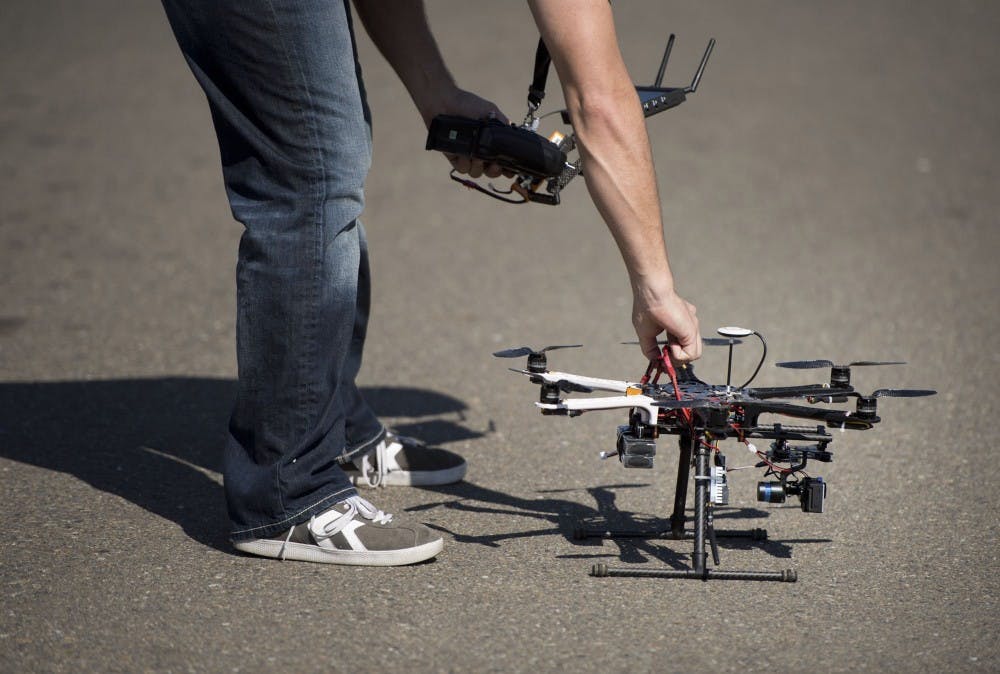Proposed rules:
• Must weigh less than 55 pounds
• Operator must remain in eyesight of drone
• Drone may not be operated over people not involved in operation
• Can only be operated during the day
• Speed must not exceed 100 mph
Drones, or unmanned aerial systems, have the potential to be used for news reporting, disaster management, conducting search and rescue missions and tracking weather, but federal law does not allow businesses to use them.
But a new proposal from the Federal Aviation Administration may open up some of those opportunities commercially. If the proposal passes, businesses would be allowed to use small drones for themselves.
Proposals from the FAA usually take about 18 months to decide.
Currently, drones are only allowed for personal use – business use is granted on a case-by-case basis from the FAA, according to knowbeforeyoufly.org.
Tim Underhill, a telecommunications instructor who is studying the media’s use of drones, said the new proposal offers some hope for people who want to use drones commercially.
“[Drones are] a great tool to use to get a really great shot but because of the previous FAA ruling, it has been difficult to do for commercial purposes,” he said.
He said being able to use drones in reporting – or even in any other aspect – would be more convenient than having to hire an aircraft to get the footage.
“I can carry a helicopter or QuadCop in my car and pull it out,” Underhill said. “There’s a lot of savings and the potential is very unlimited.”
But with the new rule proposal comes more regulations. The drones must weigh less than 55 pounds, they cannot be operated over any people not directly involved in the operation and the drone must remain in visual line of sight at all times, according to the FAA.
Underhill said some concerns with using drones for commercial purposes are safety and privacy.
However, current privacy regulations don’t prohibit putting a camera on a kite or a hot air balloon, so using the drones would be the same thing, Underhill said.
“[Safety is] really where the FAA stepped in and proposed regulations,” he said. “Because of safety regulations, some of the things you’ve heard about drones doing in the future aren’t going to happen. You aren’t going to have Amazon delivering packages to your front door. That’s what [Academy of Model Aeronautics] says and I like it.”
Brian Wynne, president and CEO of the Association for Unmanned Vehicle Systems International said in a statement that the proposed rule is a critical milestone in the drone integration process, and it is something that is overdue.
“UAS technology has largely remained grounded while many prospective users wait for the regulatory framework to catch up,” Wynne said. “This is a good first step in an evolutionary process that brings us closer to realizing the many societal and economic benefits of UAS technology.”
However, all drone users aren’t completely in agreement with the new rule proposals.
Michael Drobac, executive director of Small UAV Coalition, said while he thought the proposal is a great first step, it won’t bring us far enough to even be able to compete with other countries who use drone technology.
Japan, for example, uses drones to regulate crop production and monitor soil quality.
Some of the concerns he has are that the FAA proposal doesn’t allow, or even entertain, the opportunity for the drone to leave the eyesight of the pilot. A person isn’t even allowed to use first person view technology, like iPads or other mobile devices, to watch their drone.
“There’s a few little areas where we have to work together and work with FAA and I think the time it takes for those rules to become final may not be sufficient … to get us into a competitive position with countries like Canada, that are already allowing for commercial operations of drones under 2.2 kilograms,” Drobac said.
But Drobac said the FAA is being cautious, and reasonably so, but there isn’t anyone who is proposing to operate in an unsafe manner.
“This technology is not a new yield,” Drobac said. “We are new to it and it has evolved rapidly but I don’t think that regulators, law makers and policy makers have jumped on it as quickly as the engineers and technologists and the dreamers have.”





